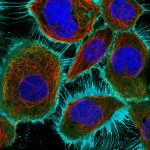Link to Pubmed [PMID] – 11071909
Mol. Biol. Cell 2000 Nov;11(11):3819-33
Analysis of the human Rab6A gene structure reveals the presence of a duplicated exon, and incorporation of either of the two exons by alternative splicing is shown to generate two Rab6 isoforms named Rab6A and Rab6A’, which differ in only three amino acid residues located in regions flanking the PM3 GTP-binding domain of the proteins. These isoforms are ubiquitously expressed at similar levels, exhibit the same GTP-binding properties, and are localized to the Golgi apparatus. Overexpression of the GTP-bound mutants of Rab6A (Rab6A Q72L) or Rab6A’ (Rab6A’ Q72L) inhibits secretion in HeLa cells, but overexpression of Rab6A’ Q72L does not induce the redistribution of Golgi proteins into the endoplasmic reticulum. This suggests that Rab6A’ is not able to stimulate Golgi-to-endoplasmic reticulum retrograde transport, as described previously for Rab6A. In addition, Rab6A’ interacts with two Rab6A partners, GAPCenA and “clone 1,” but not with the kinesin-like protein Rabkinesin-6, a Golgi-associated Rab6A effector. Interestingly, we found that the functional differences between Rab6A and Rab6A’ are contingent on one amino acid (T or A at position 87). Therefore, limited amino acid substitutions within a Rab protein introduced by alternative splicing could represent a mechanism to generate functionally different isoforms that interact with distinct sets of effectors.

